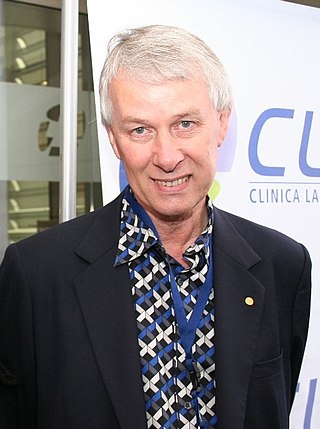Richard Roberts
English biochemist and molecular biologist From Wikipedia, the free encyclopedia
Sir Richard John Roberts FRS (born 6 September 1943, Derby) is a British biochemist and molecular biologist.
Richard Roberts | |
|---|---|
 Richard Roberts | |
| Born | 6 September 1943 |
| Nationality | British |
| Known for | introns |
| Awards | 1993 Nobel Prize in Physiology or Medicine |
| Scientific career | |
| Fields | molecular biologist |
He was awarded the 1993 Nobel Prize in Physiology or Medicine with Phillip Sharp for "the discovery that genes in eukaryotes are not contiguous strings but contain introns, and that the splicing of messenger RNA to delete those introns can occur in different ways, yielding different proteins from the same DNA sequence".[1]
Roberts has worked at Harvard University, Cold Spring Harbor Laboratory and New England Biolab. He was knighted in the 2008 Birthday Honours.[2]
Work
It used to be thought that each gene on DNA coded for a single protein in a continuous strip. Roberts and Sharp independently found out that the genes in adenovirus (which causes the common cold), were split into segments that were combined later in RNA processing.
In 1997 Roberts proved that in the adenovirus coding DNA is separated by stretches of DNA which are non-coding. The coding sections are exons, and the non-coding sections are introns.
Furthermore, it turned out that this structure occurs in all higher organisms. The discovery that a gene in could be present in the genetic material as several distinct and separate segments was revolutionary.
The second part of Robert's work was in gene-splitting and gene splicing. This means to cut pieces out of, and add pieces to, a coding sequence. This creates a protein which works differently from the original version.[3] This is now used in genetic engineering.

Suggested effect on evolution
This kind of structure may allow more flexible responses to environmental change, and so speed up evolution. The structure may also be responsible for a number of inherited genetic defects.
Here's a key part of the Nobel presentation speech by Professor Bertil Daneholt of the Nobel Assembly of the Karolinska Institute:
- "Earlier it was believed that genes evolve mainly through the accumulation of small discrete changes in the genetic material. But their mosaic gene structure also permits higher organisms to restructure genes in another, more efficient way. This is because during the course of evolution, gene segments - the individual pieces of the mosaic - are regrouped in the genetic material, which creates new mosaic patterns and hence new genes. This reshuffling process presumably explains the rapid evolution of higher organisms".[4]
References
Wikiwand - on
Seamless Wikipedia browsing. On steroids.
